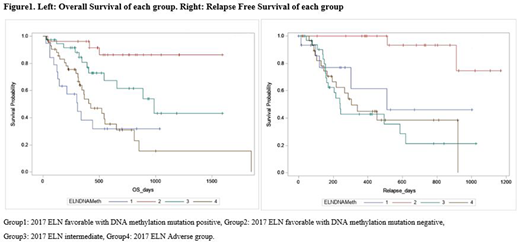Introduction
In 2017, the European LeukemiaNet (ELN) stratified AML patients into 3 risk groups based on the presence or absence of specific chromosome abnormalities and selected gene mutations.1 However, some studies have suggested that the prognosis or CR rates are heterozygous in the 2017 ELN favorable group depending on the specific co-existing mutations.2 Although they were not included in 2017 ELN due to an insufficient accumulation of evidence, some mutations involved in DNA methylation, including DNMT3A and IDH1/2, revealed adverse effects in AML prognosis.1,3-5 The goal of the current study was to evaluate how the DNA methylation regulatory (DNA-MR) gene mutations may impact the outcomes of AML patients categorized as favorable risk according to the ELN risk stratification.
Methodology
All AML patients diagnosed at our institution from 2017-08-01 to 2020-03-10 were reviewed for this study. All patient samples were tested for morphologic evaluation, flow cytometry immunophenotyping, conventional karyotyping and next generation sequencing using a target panel covering 53 AML related genes, including DNA-MR genes: DNMT3A, TET2, IDH1, IDH2 or SETBP1. All AML cases were then classified based on 2016 WHO classification of AML, and risk groups were assigned using the ELN risk stratification scheme. Treatment-related AML patients were excluded. Afterward, patients aged 18 - 75 who underwent intensive induction chemotherapy were included for survival and response rate analysis, since the ELN risk stratification scheme was built primarily based on this population. The patients were divided into 4 groups: 1) ELN favorable with at least one mutation of DNA-MR genes 2) ELN favorable without DNA-MR gene mutations, 3) ELN intermediate, and 4) ELN adverse. The log-rank test was used to compare the OS and RFS difference between 4 groups. CR rates were compared by chi-square test or Fischer's exact test. Bonferroni adjustment was performed to prevent type I error at a level of 0.8%. Two-tailed statistical significance at a level of 5% was used for statistical analysis. All analyses were performed using SAS 9.4 (SAS Institute, Cary, NC) and R RStudio Team (2020).
Results
A total of 125 patients were qualified for the study and the median follow-up for the cohort was 404 days. Among ELN favorable risk patients (n = 45), the mutations of DNA-MR genes occurred in 19 (42.2%) patients: DNMT3A, 20% (9/45); IDH2, 13% (6/45); TET2, 11% (5/45); IDH1, 9% (4/25). This led to 19, 26, 38, and 42 patients classified as Groups 1, 2, 3 and 4 respectively. In contrast, DNA-MR gene mutations were less common in ELN intermediate and adverse groups, and occurred in 34.2% (13/38) and 19.0% (8/42) respectively. Figure 1 shows OS and RFS of 4 groups by Kaplan-Myer Curve. The median OS for groups 1, 2, 3 and 4 were 306, not reached, 987, and 422 days, respectively. There was significant difference in OS between ELN favorable with versus without DNA-MR gene mutations (Group 1 vs 2; p-value: 0.0002). There was no significant OS difference between ELN favor with DNA-MR gene mutations versus ELN intermediate (Group 1 vs 3; p-value: 0.0921) or versus ELN adverse group (Group 1 vs 4; p-value: 0.9455). The median RFS for groups 1, 2, 3 and 4 were 511, not reached, 240, and 305 days. There was significant difference in RFS between ELN favorable with versus without DNA-MR gene mutations (Group 1 vs 2: adjusted p-value:0.0089). There were no significant RFS differences between ELN favorable with DNA-MR gene mutations versus intermediate (Group 1 vs 3; p value: 0.2304) or versus adverse group (Groups 1 vs 4; p-value: 0.6661). CR rate of groups 1, 2, 3 and 4 were 79%, 96%, 82% and 57% respectively. The CR rate of Group 1 was not statistically significantly different from CR rate of Group 2, 3, and 4. Further subgroup analysis revealed that the co-existing DNA-MR gene mutations did not impact OS and RFS in ELN intermediate and adverse groups.
Discussion
Our results indicate that mutations of DNA methylation regulatory genes are common in AML patients with ELN favorable risk. Furthermore, these mutations lead to poor prognosis of this subgroup of patients considered favorable risk, with OS and RFS similar to that of patients in the ELN adverse risk group. Currently this subgroup of patients does not receive upfront stem cell transplant due to the favorable outcome and thus may not receive adequate treatment. Further studies are warranted to confirm our observations.
No relevant conflicts of interest to declare.
Author notes
Asterisk with author names denotes non-ASH members.


This feature is available to Subscribers Only
Sign In or Create an Account Close Modal